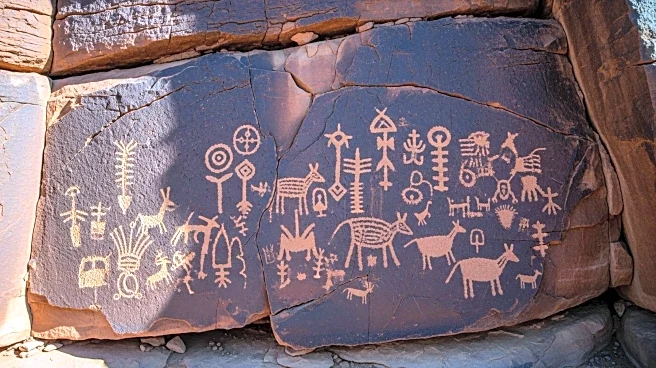What is the story about?
What's Happening?
Archaeologists in Saudi Arabia have uncovered over 170 ancient rock engravings, believed to be among the earliest monumental artworks in the region. These engravings, created between 12,800 and 11,400 years ago, depict animals such as camels, ibex, equids, gazelles, and aurochs. The discovery was made by an international team coordinated by the Heritage Commission of the Saudi Ministry of Culture, as part of the Green Arabia Project. The engravings were found across three locations in northern Saudi Arabia: Jebel Arnaan, Jebel Mleiha, and Jebel Misma. The artwork corresponds to a period when temporary lakes and rivers reappeared after centuries of extreme aridity, providing essential support for human groups venturing into the desert.
Why It's Important?
The discovery of these engravings is significant as it provides insight into the social and symbolic sophistication of early human groups in northern Arabia. The rock art likely marked territories and migration routes, revealing a distinct cultural identity adapted to life in a challenging, arid environment. This finding fills a critical gap in the archaeological record of northern Arabia between the Last Glacial Maximum and the Holocene, highlighting the resilience and innovation of early desert communities. The engravings also suggest long-distance connections to Pre-Pottery Neolithic populations in the Levant region, indicating a broader network of cultural exchange.
What's Next?
The Green Arabia Project will continue to explore and document more sites in the region, aiming to uncover further evidence of early human presence and activity. Researchers will focus on understanding the cultural significance of the engravings and their role in marking water sources and movement routes. The interdisciplinary approach of the project may lead to new insights into the adaptation strategies of ancient communities in arid environments.
Beyond the Headlines
The monumental rock art not only serves as a historical record but also raises questions about the ethical considerations of preserving such sites. As tourism and development increase in the region, there is a need to balance accessibility with conservation efforts to protect these cultural treasures. The findings also contribute to the broader understanding of human migration and adaptation during significant climatic transitions.
AI Generated Content
Do you find this article useful?













